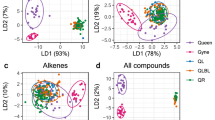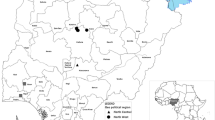Abstract
The postpharyngeal gland (PPG) has long been assumed to be restricted to ants, where it mainly functions in the maintenance of social integrity. Recently, a PPG has been described in both sexes of a solitary digger wasp, the European beewolf, Philanthus triangulum (Hymenoptera, Crabronidae). Female beewolves use the contents of their PPG to embalm their honeybee prey to delay microbial growth. Here we show that in male beewolves, the PPG serves as a reservoir of the pheromone used to scent-mark their territories. Gas chromatography-mass spectrometry (GC-MS) analysis of PPG contents identified 55 substances including long-chain aliphatic hydrocarbons, and 13 substances with functional groups. The composition was consistent with the composition of the marking pheromone of male European beewolves described earlier. Comparisons of the PPG contents, and total-head extracts showed a strong congruency, suggesting that total-head extracts can be used for the analysis of marking secretion in beewolves. Furthermore, we found a dimorphism in the composition of the PPG contents, based on significant differences in the proportions of seven compounds between the two morphs.




Similar content being viewed by others
References
Aitchison, J. 1986. The Statistical Analysis of Compositional Data. Chapman & Hall, London.
Alcock, J. 1975. Territorial behaviour by males of Philanthus multimaculatus (Hymenoptera: Sphecidae) with a review of territoriality in male sphecids. Anim. Behav. 23:889–895.
Aldrich, J. R. 1988. Chemical ecology of the Heteroptera. Annu. Rev. Entomol. 33:211–238.
Aldrich, J. R., Oliver, J. E., Waite, G. K., Moore, C., and Waters, R. M. 1996. Identification of presumed pheromone blend from Australasian predaceous bug, Oechalia schellenbergii (Heteroptera: Pentatomidae). J. Chem. Ecol. 22:729–738.
Andersen, J. F., Buchman, S. L., Weisleder, D., Plattner, R. D., and Minckley, R. L. 1988. Identification of thoracic gland constituents from male Xylocopa spp. Latreille (Hymenoptera: Anthophoridae) from Arizona. J. Chem. Ecol. 14:1153–1163.
Arn, H., Rauscher, S., Guerin, P., and Buser, H.-R. 1988. Sex pheromone blends of three tortricid pests in European vineyards. Agric. Ecosyst. Environ. 21:111–117.
Bergström, G. 1985. Marking pheromones of Megabombus sylvarum (L.) and M. ruderarius (Müller) males (Hymenoptera: Apidae). Apidologie 16:57–68.
Blum, M. S. 1992. Honey bee pheromones, pp. 373–400, in J. Graham (ed.). The Hive and the Honey Bee. Dadant and Sons, Hamilton.
Borg-Karlson, A.-K. and Tengö, J. 1980. Pyrazines as marking volatiles in philanthine and nyssonine wasps (Hymenoptera: Sphecidae). J. Chem. Ecol. 6:827–835.
Cabrera, A., Williams, D., Hernàndez, J. V., Caetano, F. H., and Jaffe, K. 2004. Metapleural- and postpharyngeal-gland secretion from workers of the ants Solenopsis invicta and S. geminata. Chem. Biodivers. 1:303–311.
Carlson, D.-A., Bernier, U.-R., and Sutton, B.-D. 1998. Elution patterns from capillary GC for methyl-branched alkanes. J. Chem. Ecol. 24:1845–1865.
Crozier, R. H. and Dix, M. W. 1979. Analysis of two genetic models for the innate components of colony odour in social Hymenoptera. Behav. Ecol. Sociobiol. 4:217–224.
Donzé, G., Schnyder-Candrian, S., Bogdanov, S., Diehl, P.-A., Guerin, P. M., Kilchenman, V., and Monachon, F. 1998. Aliphatic alcohols and aldehydes of the honey bee cocoon induce arrestment behavior in Varroa jacobsoni (Acari: Mesostigmata), an ectoparasite of Apis mellifera. Arch. Insect Biochem. 37:129–145.
Eelen, D., Børgesen, L., and Billen, J. 2006. Functional morphology of the postpharyngeal gland of queens and workers of the ant Monomorium pharaonis (L.). Acta Zool.-Stockholm 87:101–111.
Evans, H. E. and O’neill, K. M. 1988. The Natural History and Behavior of North American Beewolves. Comstock Publishing Associates, Ithaca, NY.
Gnatzy, W., Volknandt, W., and Schulz, S. 2004. Dufour gland of the digger wasp Liris niger: Structure and developmental and biochemical aspects. Cell Tissue Res. 315:125–138.
Gwynne, D. T. 1978. Male territoriality in the bumble bee wolf Philanthus bicinctus (Mickel) (Hymenoptera: Sphecidae): Observations on the behaviour of individual males. Z. Tierpsychol. 47:89–103.
Hefetz, A., Errard, C., Chambris, A., and Negrate, A. L. 1996. Postpharyngeal gland secretion as a modifier of aggressive behavior in the myrmicine ant Manica rubida. J. Insect Behav. 9:709–717.
Herzner, G. 2004. Evolution of the pheromone communication system in the European beewolf Philanthus triangulum F. (Hymenoptera: Crabronidae). PhD dissertation. Würzburg University, Würzburg, Germany.
Herzner, G., Schmitt, T., Linsenmair, K. E., and Strohm, E. 2005. Prey recognition by females of the European beewolf and its potential for a sensory trap. Anim. Behav. 70:1411–1418.
Herzner, G., Goettler, W., Kroiss, J., Purea, A., Webb, A., Jakob, P., Roessler, W., and Strohm, E. in press. Males of a solitary wasp, the European beewolf Philanthus triangulum (Hymenoptera, Crabronidae), possess a postpharyngeal gland. Arthropod Struct. Develop.
Herzner, G., Schmitt, T., Heckel, F., Schreier, P., and Strohm, E. 2006. Brothers smell similar: Variation in the sex pheromone of male European beewolves Philanthus triangulum F. (Hymenoptera: Crabronidae) and its implications for inbreeding avoidance. Biol. J. Linn. Soc. 89:433–442
Higashi, M., Takimoto, G., and Yamamura, N. 1999. Sympatric speciation by sexual selection. Nature 402:523–526.
Ho, H.-Y., Kou, R., and Tseng, H.-K. 2003. Semiochemicals from the predatory stink bug Eocanthecona furcellata (Wolff): Components of metathoracic gland, dorsal abdominal gland, and sternal gland secretions. J. Chem. Ecol. 29:2101–2114.
Hölldobler, B. and Wilson, E. O. 1990. The Ants. Springer, Berlin.
Kaib, M., Eisermann, B., Schoeters, E., Billen, J., Franke, S., and Francke, W. 2000. Task-related variation of postpharyngeal and cuticular hydrocarbon composition in the ant Myrmicaria eumenoides. J. Comp. Physiol. A 186:939–948.
Kaltenpoth, M. and Strohm, E. 2006. The scent of senescence: Age-dependent changes in the composition of the cephalic gland secretion of the male European beewolf, Philanthus triangulum. J. Insect Sci. (Tucson) 6:20, available online: insectscience.org/6.20
Kaneshiro, K., and Boake, C. 1987. Sexual selection and speciation: Issues raised by Hawaiian Drosophila. Trends Ecol. Evol. 2:207–212.
Kullenberg, B., Bergström, G., and Ställberg-Stenhagen, S. 1970. Volatile components of the marking secretion of male bumblebees. Acta Chem. Scand. 24:1481–1483.
Lande, R. 1981. Models of speciation by sexual selection on polygenic traits. PNAS 78:3721–3725.
Legendre, P. and Legendre, L. 1998. Numerical Ecology. Elsevier, Amsterdam.
Lenoir, A., Fresneau, D., Errard, C., and Hefetz, A. 1999. Individuality and colonial identity in ants: The emergence of the social representation concept, in C. Detrain, J. L. Deneubourg, and J. M. Pasteels (eds.). Information Processing in Social Insects. Birkhäuser Verlag, Basel.
Lucas, C., Pho, D.-B., Fresneau, D., and Jallon, J.-M. 2004. Hydrocarbon circulation and colonial signature in Pachycondyla villosa. J. Insect Physiol. 50:595–607.
Mcdaniel, C. A., Schmidt, J. O., and Howard, R. W. 1992. Mandibular gland secretions of the male beewolves Philanthus crabroniformis, P. barbatus, and P. pulcher (Hymenoptera: Sphecidae). J. Chem. Ecol. 18:27–37.
Melo, G. A. R. 1999. Phylogenetic relationships and classification of the major lineages of Apoidea (Hymenoptera), with emphasis on the crabronid wasps. Sci. Pap. Nat. Hist. Mus. Univ. Kans. 14:1–55.
Oldham, N., Morgan, E., Agosti, D., and Wejmer, R. 1999. Species recognition from postpharyngeal gland contents of ants of the Cataglyphis bicolor group. J. Chem. Ecol. 25:1383–1393.
O’neill, K. M. 1979. Territorial behavior in males of Philanthus psyche (Hymenoptera, Sphecidae). Psyche 86:19–43.
O’neill, K. M. 1983. Territoriality, body size, and spacing in males of the beewolf Philanthus basilaris (Hymenoptera; Sphecidae). Behaviour 86:295–321.
Quicke, D. 1997. Parasitic Wasps. Chapman and Hall, London.
Rathmayer, W. 1962. Das Paralysierungsproblem beim Bienenwolf Philanthus triangulum F. (Hym. Sphec.). Z. Vergl. Physiol. 45:413–462.
Reyment, R. A. 1989. Compositional data analysis. Terra Nova 1:29–34.
Schmidt, J. O., O’neill, K. M., Fales, F. M., Mcdaniel, C. A., and Howard, R. W. 1985. Volatiles from mandibular glands of male beewolves (Hymenoptera: Sphecidae, Philanthus) and their possible roles. J. Chem. Ecol. 11:895–901.
Schmidt, J. O., Mcdaniel, C. A., and Simon Thomas, R. T. 1990. Chemistry of male mandibular gland secretions of Philanthus triangulum. J. Chem. Ecol. 16:2135–2143.
Schmidt, T., Strohm, E., Herzner, G., Bicchi, C., Krammer, G., Heckel, F., and Schreier, P. 2003. (S)-2,3-Dihydrofarnesoic acid, a new component in cephalic glands of male European beewolves Philanthus triangulum. J. Chem. Ecol. 29:2469–2479.
Schoeters, E. and Billen, J. 1997. The post-pharyngeal gland in Dinoponera ants (Hymenoptera: Formicidae): Unusual Morphology and changes during the secretory process. Int. J. Insect Morphol. 25:443–447.
Simon Thomas, R. T. and Poorter, E. P. R. 1972. Notes on the behaviour of males of Philanthus triangulum (F.) (Hymenoptera, Sphecidae). Tijdschr. Entomol. 115:141–151.
Soroker, V., Vienne, C., Nowbahari, E., and Hefetz, A. 1994. The postpharyngeal glands as a ‘Gestalt’ organ for nestmate recognition in the ant Cataglyphis niger. Naturwissenschaften 81:510–513.
Soroker, V., Hefetz, A., Cojocaru, M., Billen, J., Franke, S., and Francke, W. 1995. Structural and chemical ontogeny of the postpharyngeal gland in the desert ant Cataglyphis niger. Physiol. Entomol. 20:323–329.
Soroker, V., Fresneau, D., and Hefetz, A. 1998. Formation of colony odor in ponerine ant Pachycondyla apicalis. J. Chem. Ecol. 24:1077–1090.
Strohm, E. 1995. Allokation elterlicher Investitionen beim Europäischen Bienenwolf Philanthus triangulum Fabricius (Hymenoptera: Sphecidae). Verlag Dr. Köster, Berlin.
Strohm, E. and Lechner, K. 2000. Male size does not affect territorial behaviour and life history traits in a sphecid wasp. Anim. Behav. 59:183–191.
Strohm, E. and Linsenmair, K. E. 1997. Low resource availability causes extremely male-biased investment ratios in the European beewolf, Philanthus triangulum F. (Hymenoptera: Sphecidae). Proc. Roy. Soc. Lond. B Biol. 264:423–429.
Strohm, E. and Linsenmair, K. E. 1999. Measurement of parental investment and sex allocation in the European beewolf Philanthus triangulum F. (Hymenoptera: Sphecidae). Behav. Ecol. Sociobiol. 47:76–88.
Strohm, E. and Linsenmair, K. E. 2001. Females of the European beewolf preserve their honeybee prey against competing fungi. Ecol. Entomol. 26:198–203.
Strohm, E., Herzner, G., and Goettler, W. in press. A ‘social’ gland in a solitary wasp? The postpharyngeal gland of female European beewolves (Hymenoptera, Crabronidae). Arthropod Struct. Develop.
Tobares, L., Guzmán, C., and Maestri, D. 2003. Effect of the extraction and bleaching processes on jojoba (Simmondsia chinensis) wax quality. Eur. J. Lipid Sci. Technol. 105:749–753.
Vienne, C., Soroker, V., and Hefetz, A. 1995. Congruency of hydrocarbon pattern in heterospecific groups of ants: Transfer and/or biosynthesis? Insect Soc. 42:267–277.
Wilson, E. O. 1972. Insect Societies. Harvard University Press, Cambridge, USA.
Yasui, H., Akino, T., Yasuda, T., Fukaya, M., Ono, H., and Wakamura, S. 2003. Ketone components in the contact sex pheromone of the white-spotted longicorn beetle, Anoplophora malasiaca, and pheromonal activity of synthetic ketones. Entomol. Exp. Appl. 107:167–176.
Zhang, Q.-H. and Aldrich, J.-R. 2003. Male-produced anti-sex pheromone in a plant bug. Naturwissenschaften 90:505–508.
Acknowledgement
We thank Martin Kaltenpoth for maintaining GC-MS setup 1 and Frank Heckel for maintaining GC-MS setup 2. This study was supported by the German Science Foundation DFG (SFB 554 TP B3 and STR 532/ 1–2).
Author information
Authors and Affiliations
Corresponding author
Rights and permissions
About this article
Cite this article
Kroiss, J., Schmitt, T., Schreier, P. et al. A Selfish Function of a “Social” Gland? A Postpharyngeal Gland Functions as a Sex Pheromone Reservoir in Males of the Solitary Wasp Philanthus triangulum . J Chem Ecol 32, 2763–2776 (2006). https://doi.org/10.1007/s10886-006-9198-5
Published:
Issue Date:
DOI: https://doi.org/10.1007/s10886-006-9198-5




